Picture Book Round-Up, Part I’m-Gonna-Stop-Counting
 May 19th, 2007 by jules
May 19th, 2007 by jules
Yeah, I need to just drop the whole parts-to-a-whole idea on my picture book round-ups. If you haven’t noticed, I’m trying to be more productive when it comes to reviewing new picture books, and I have decided to review as many new titles as I can this year. Perhaps at the end of the year, I can say that here at 7-Imp I reviewed (or co-reviewed with Eisha) a Cybil winner or the Caldecott Honor or some such thing. Plus, I enjoy it immensely. Even if I didn’t have two young children who enjoy them, too, I’d be returning from the library with a huge stack of them every week.
So, I’m going to forgo the whole Part So-and-So idea and continue reviewing as many of them as I possibly can in various and asundry picture book round-ups. Onwards then . . .
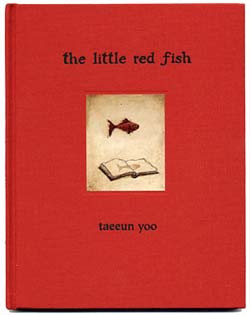
by Taeeun Yoo
Dial Books for Young Readers
March 2007
(library copy)
I made that book cover image huge on purpose. Isn’t that a handsome book? There’s no dust jacket; the book is covered in a rich red fabric; the black letters you see there (the title and author/illustrator) are embossed; the wonderfully weird small illustration centered there does not overwhelm the cover; and the endpages are mysterious and gorgeous. Keep going, and it gets even better. Yoo’s detailed watercolored etchings are simply divine. For the most part, they’re rather opaque, but then Yoo knows exactly when to bring the light in. The colors are primarily sepia-toned — nothing more than browns, blacks, and a bit of grey — until the fish appears in bright red . . . Yes, JeJe is visiting his grandfather at his old library in the middle of the forest, and he’s brought along his little red fish for the visit. It’s the first time JeJe’s ever seen the library, crammed with books wall-to-wall, and he’s amazed and explores freely. He soon falls asleep, and when he wakes, the room is dark and empty, and “{h}e felt as though he had been swallowed up by the darkness.” He then notices, while a bit nervously reading by the light of the moon, that his fishbowl is empty. After seeing a glimpse of his fish’s red tail high up on a shelf and picking up an old, dusty book in which he thinks he sees his pet, a huge wave and all kinds of red fish leap out of the book and, eventually, JeJe falls down into the book itself. Thus begins five lovely, wordless spreads (very much invoking Japanese woodblock prints or silkscreen landscapes) in which we take our journey with JeJe to find his fish, involving a fantastical, thrilling ride over the ocean with some flamingoes. The boy does return and, it probably goes without saying, is eager to visit the library again very soon. Did he find a magical book? Was it a dream? That’s for the young reader to decide. The entire experience of this book is refreshing and enchanting, what with all the very busy picture books out there today. Take a moment to enter this remarkable library in Yoo’s remarkable, mystifying tale. As Publishers Weekly nailed it, “Yoo’s exhilarating visual images don’t really need words. They seem to call to a place beyond language, and shutting the book feels like awakening from a dream.”
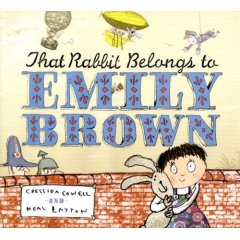
by Cressida Cowell
and illustrated by Neal Layton
Hyperion Books for Children
April 2007
(library copy)
Set aside your tired ‘ol copy of The Velveteen Rabbit and make way for Emily Brown and Stanley (I say that respectfully; as a child, I read Margery Williams’ story often enough that I could recite the first page). My oh my this story is just rockin’, and then throw in Neal Layton’s wonderfully erratic, rather unpredictable illustrations. This time there is no scratching-out of letters (as with his illustrations for last year’s Extreme Animals), but his art work for this title exhibits his signature intentionally-unpolished style with his refreshing sort of nonchalance and spontaneity (particularly in the form of his sometimes scribbling) . . . Emily Brown has an old gray rabbit named Stanley. Together they embark on a series of wildly imaginative adventures (launching themselves into outer space, riding on a motorbike through the Sahara Desert, deep-sea diving off the Great Barrier Reef, and much more). In the midst of each adventure, some servant of the Queen — from the Chief Footman to the entire Army to the entire Navy to the entire Air Force — appears and proclaims that the Queen “has very kindly noticed your rabbit. She would like to have that Bunnywunny. In return, she offers this brand-new teddy bear.” Spunky Emily politely turns them down each time (though she grows increasingly cross), emphasizing that her rabbit is NOT for sale and that his name isn’t Bunnywunny. It’s Stanley. Besides, that bear is a bit too stiff, needs to be broken in a bit. Each time someone new appears, they announce that the queen has upped her ante and now offers the brand-new golden teddy bear and something else (ten talking dolls that say “Mama, Mama,” for instance). Eventually, the Special Commandos appear one night and steal the rabbit that belongs to Emily Brown. Heading straight to “that naughty Queen” the next day, she is prepared to scold Her Majesty and try to win back Stanley when the Queen immediately cries upon seeing Emily that she needs her help, that “there’s something wrong with Bunnywunny!” Sure enough, the Royal Dressmakers had screwed him up, trying to wash him in the washing machine. Declaring that she’ll take Stanley home and feeling sorry for the Queen, she gets the Queen’s brand-new golden teddy bear, places it in the Queen’s lap, and whispers:
You take that brand-new teddy bear and you play with him all day. Sleep with him at night. Hold him very tight and be sure to have lots of adventures. And then maybe one day you will wake up with a real toy of your OWN.
Oh yes, it’s a heart-rending little moment there, and I admit that I teared up a bit. How. perfect. is. that? I ask you. Yes, we have a brand new unforgettable heroine of children’s lit, Emily Brown, who knows right smack dab and deep in the center of her heart exactly what loyalty means . . . Layton’s mixed media photo-collage illustrations are both funny and tremendously child-centered, making this one brim with child appeal for the wee ones who take the time to take in Layton’s merry-making. Three cheers for Emily Brown!
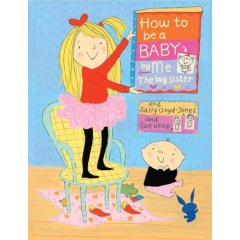
By Me, the Big Sister
by Sally Lloyd-Jones
and illustrated by Sue Heap
Schwartz & Wade
February 2007
(review copy)
This amusing and sweet-tempered title opens with a world-weary big sister reading from a book she’s written for her new baby sibling: “When you’re a baby, you are in a crib and not in school. When you’re a baby, you just wear your pajamas ALL THE TIME and not real clothes . . . You sing songs, but you don’t know the words. Or the tune. (I know the words and the tune AND THE DANCE.)” A bit later, the hand-lettered lists appear, entitled “HERE’S WHAT ELSE YOU CAN’T DO”; “HERE’S WHAT ELSE YOU CAN’T EAT”; “HERE’S WHAT ELSE YOU ARE SCARED OF”; and “HERE’S WHAT ELSE YOU DON’T KNOW.” There’s even a page in which she explains to her poor, unknowing sibling how people call babies “Muffin or Pumpkin or Peanut or Dumpling, and people say, ‘I could EAT you ALL UP!'” (Don’t you know, Sendak has said before, that children take you literally and that instills a bit ‘o fear in their wee hearts? Well, I can’t help it; those words slip from my mouth all the time, too). To the big sister, the crib is “prison” when the baby is naughty, and the baby doesn’t have any real friends (“I have lots.)” There’s a moment in which the big sister shares the frustrations of having to share her home with a new sibling (“HERE’S WHAT ELSE YOU DO THAT’S ILLEGAL,” including “open other people’s presents” and “Knock other people’s castles over”), but the over-riding tone is a sweet-‘n-sassy one on the part of our narrator. Our wee author, with the help of Lloyd-Jones and Heap, even shows us how she comforts the baby at night when he’s had a scary dream, even providing a “HERE’S WHAT ELSE BABIES ARE GOOD AT” list and looking into the future to when the baby will grow and learn from big sister. The word choices and cadence of speech and the protagonist’s overall voice are spot-on for a young child’s (“When you’re a baby, you don’t carry a backpack. You go in one. And you can only sit. You can’t stand, or walk, or go ANYWHERE. People have to carry you EVERYWHERE”). Heap’s acrylic and crayon illustrations are rendered in bright pastels and will draw children in with their heavy dose of child-appeal. There’s much humor in this title, and it will go far in both entertaining and in being cathartic for children trying to acclimate themselves to their new role as big sibling.
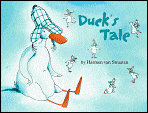
by Harmen van Straaten
(translation by Marianne Martens)
First published in 2003 in Holland under the title
Het verhaal van Eend
English translation copyright 2007
NorthSouth Books
(review copy)
Here we have another Dutch picture book import, this one a subdued story about friendship that is completely devoid of any pretension. Oh have mercy, it actually almost chokes me up each and every time I read it, as it rings true so loud, so clearly and without an ounce of strenuous effort or artificiality. The book opens on a hot and humid day, and Duck — in his over-sized deerstalker (à la Sherlock Holmes) and gripping a pen in hand — stops by Toad’s house to ask if he’d like to go for a swim. Toad — who tries very, very hard to be Brilliant and Important (though a large part of this book’s charm is that van Straaten never tells us this; it’s all inherent in the dialogue and characterizations: “Toad had a big medal pinned to his chest. He told Duck that he’d gotten it for showing extraordinary courage. But according to Otter, Toad had found the medal. Just like he had found the reading glasses”) — is sitting at his desk when Duck arrives, muttering to himself, “‘Ah hah . . . I see'” and announces a bit too vigorously that he’s reading very important material. It’s clear that Toad doesn’t want to join Duck on his swim, so off he heads for his swim by himself, realizing that if Toad can read because he has glasses, he can write because he has a pen! Better yet, whatever he writes Toad can read to him later. Down he sits at the dock to scribble on his paper, concentrating very hard. Of course, he’s not progressing beyond anything other than scribbling nonsense, but that’s for your young reader(s) to figure out with their burgeoning inferencing skills. When Toad and all their other friends show up later, Duck asks him to read: “‘Please, Toad? You have such a beautiful voice — and reading glasses!'” Awkwardly, Toad hesitates but takes a deep breath and, uh, reads Duck’s story (insert young reader’s inferencing skills once again — Toad, of course, doesn’t have the slightest clue as to how to read it). Thus begins the story-within-the-story, “Duck’s Tale,” in bold type and a handwritten-esque font. “Duck’s Tale,” completely made up on the fly by Toad, is a simple, affectionate story of friendship with Otter, Hedgehog, and Duck as the cast of characters. At the close of “Duck’s Tale,” Otter and Hedgehog are almost speechless, and Duck looks at the ground: “‘Toad read it so beautifully,’ he said.” Does he now know that Toad is pretending to read? Or is he not aware that he wrote scribbles and doubly impressed by Toad’s flair for dramatic recitations? Who knows, and no matter, because it’s such a tender moment in all its understated glory, the point being that Duck realizes, “What good friends I have . . .” Van Straaten’s line drawings and watercolors are beautiful; like Taeeun Yoo (see above), he knows how much stunning effect can be achieved with just the right amount of light (his use of yellow for the shimmering sunlight on the river where the animals live is pure loveliness). Duck — and even ostentatious Toad — are undeniably lovable. I hope we see further stories of their friendship.
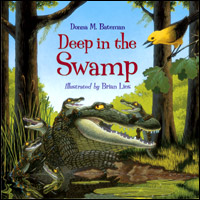
by Donna M. Bateman
and illustrated by Brian Lies
Charlesbridge Publishing
January 2007
(library copy)
Remember last year’s Bats at the Beach (reviewed here by Yours Truly) and Brian Lies’ beautiful acrylic paintings? Well, he’s back, and he’s still got it goin’ on in this wonderful piece of non-fiction by Donna M. Bateman. This is a re-telling of the counting rhyme “Over in the Meadow,” set in the Okefenokee Swamp. We meet river otters, snapping turtles, flame birds, marsh rabbits, alligators, blue herons, and much more. Bateman’s rhymes are delightfully rhythmic (her meter never off) and make this one a winning read-aloud. “Clever internal rhyme, alliteration and careful attention to scansion make this an unusually well-done adaptation,” wrote Kirkus Reviews (and they’re so right that I’m just borrowing their words here). See for yourself:
Deep in the swamp where the cypress reach to heaven,
Lived a mother damselfly and her little flies Seven.
“Dry!” said the mother. “We dry,” said the Seven.
So they dried their new wings where the cypress reach to heaven.
Lies scores again with his acrylic paintings (“Lies’s meticulous and glowing acrylic illustrations feature myriad shades of green, yellow, and blue, calling to mind an Audubon painting,” wrote School Library Journal). Bateman and Lies have done their research and done it well, even closing the book with “Swamp Flora and Fauna Facts” and including a note for each animal about the relationship the mother animal has with her young (bullfrog mothers, for instance, “do not stay to care for the eggs or tadpoles, some of which are eaten by animals,” and rat snake mothers “sometimes coil around their eggs but do not raise their babies”; but both heron parents share the incubation of their eggs and feeding of the chicks). And adding those notes about the flora as well? Nice touch. Great counting book; great book in rhyme; great book for a science class, studying flora and fauna of any region; great book for the clever adaptation of the old counting verses and the detailed arwork . . . Just don’t overlook this title this year; it’s well worth seeing — and hearing.

LOVE the little red fish. reminds me of old school picture books without the dust jackets – sturdy, inviting because it seems like much more than a kiddie book. can’t wait to read it!
[…] including Donna M. Bateman’s Deep in the Swamp (Charlesbridge) from last year, reviewed here at 7-Imp. Yes, move over Audubon: Lies’ acrylics are detailed, precise, and—as School […]